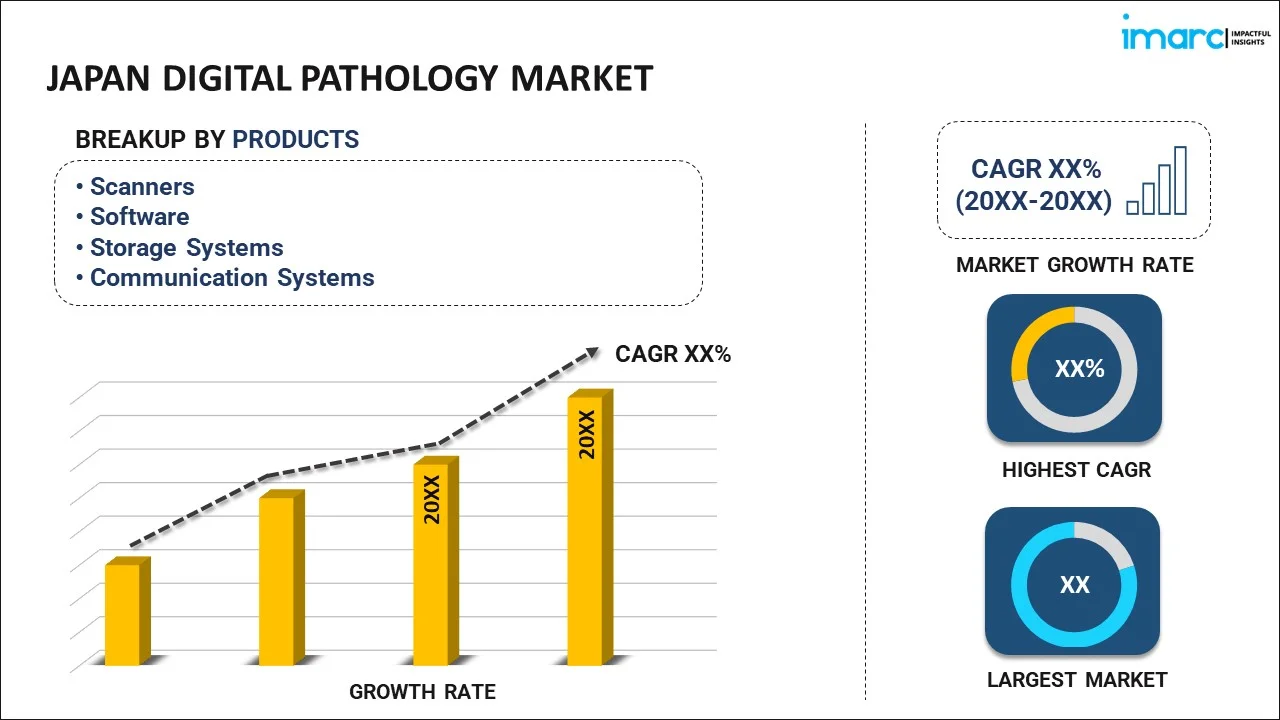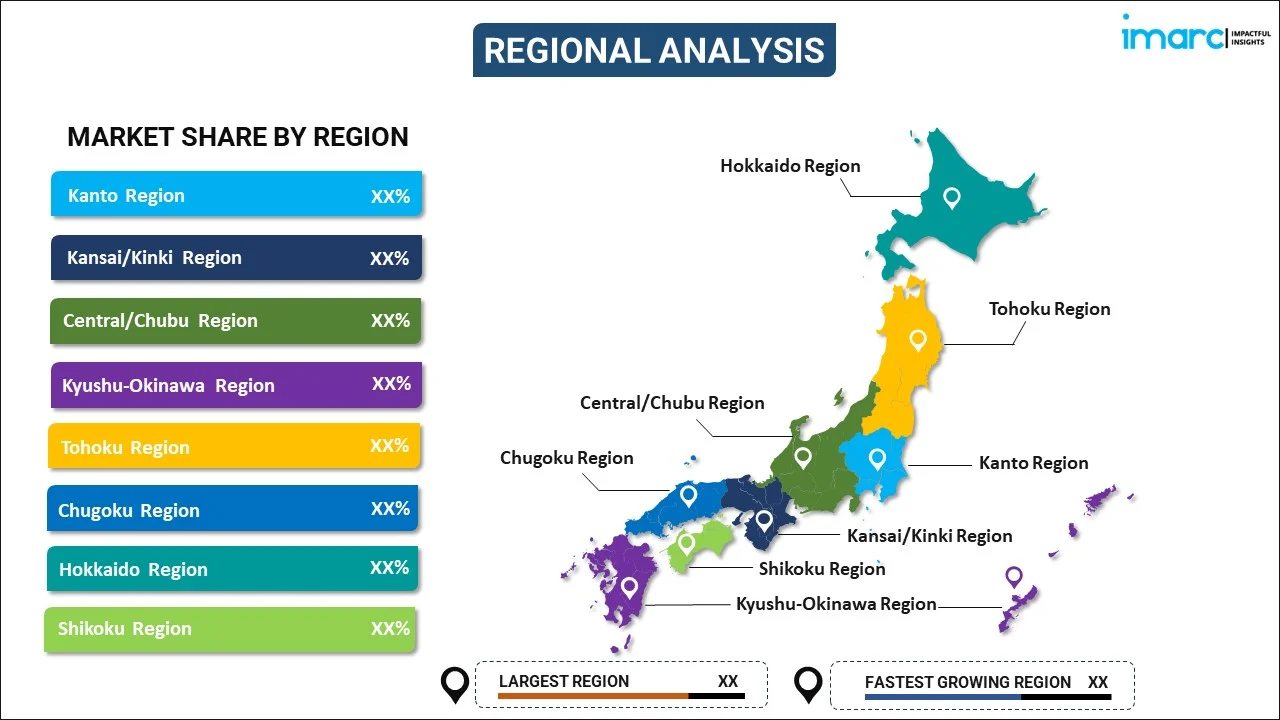
Japan Digital Pathology Market Report by Product (Scanners, Software, Storage Systems, Communication Systems), Type (Human Pathology, Veterinary Pathology), Delivery Model (On-premises, Hosted), Application (Training and Education, Consulting Services, Intraoperative Consultation, Routine Diagnostic Consultation Services, and Others), End User (Pharmaceutical and Biotechnology Companies, Hospitals and Reference Laboratories, Academic and Research Institutes), and Region 2025-2033
Market Overview:
Japan digital pathology market size reached USD 41.0 Million in 2024. Looking forward, IMARC Group expects the market to reach USD 128.1 Million by 2033, exhibiting a growth rate (CAGR) of 12.83% during 2025-2033. The widespread investments by key players in the healthcare technologies are primarily driving the market growth.
|
Report Attribute
|
Key Statistics
|
|---|---|
|
Base Year
|
2024 |
|
Forecast Years
|
2025-2033 |
|
Historical Years
|
2019-2024
|
| Market Size in 2024 | USD 41.0 Million |
| Market Forecast in 2033 | USD 128.1 Million |
| Market Growth Rate (2025-2033) | 12.83% |
Digital pathology is a cutting-edge medical technology that revolutionizes the traditional practice of examining tissue samples for disease diagnosis. Instead of using conventional glass slides, digital pathology involves the digitization of tissue samples into high-resolution images. These digital images are then stored, analyzed, and shared electronically, enabling pathologists and medical professionals to collaborate and make diagnoses remotely. Digital pathology offers numerous advantages, including improved accuracy, speed, and efficiency in diagnosing diseases such as cancer. It also facilitates the integration of artificial intelligence and machine learning algorithms, which can assist in automating certain aspects of image analysis and enhancing diagnostic precision. Additionally, digital pathology allows for the creation of extensive digital archives, enabling researchers to access and study a vast repository of medical data for various purposes, including medical research, education, and quality assurance in healthcare settings.
Japan Digital Pathology Market Trends:
The digital pathology market in Japan is witnessing significant growth and transformation within the country's healthcare landscape. Japan, known for its technological advancements, is embracing digital pathology as a powerful tool to enhance disease diagnosis and patient care. The adoption of this technology streamlines the process of tissue sample analysis by digitizing pathology slides, allowing for remote collaboration among pathologists and enabling faster and more accurate diagnoses. With a growing aging population, the demand for precise and timely pathology services is increasing, making digital pathology an invaluable asset in managing healthcare needs efficiently. Additionally, the integration of artificial intelligence and machine learning into digital pathology systems is enhancing diagnostic capabilities further. These innovations not only improve diagnostic accuracy but also help address the challenges posed by a shortage of pathologists in the country. As Japan continues to invest in healthcare technologies, the digital pathology market is poised for continued growth and innovation to meet the evolving demands of the healthcare sector.
Japan Digital Pathology Market Segmentation:
IMARC Group provides an analysis of the key trends in each segment of the market, along with forecasts at the country level for 2025-2033. Our report has categorized the market based on product, type, delivery model, application, and end user.
Product Insights:

- Scanners
- Software
- Storage Systems
- Communication Systems
The report has provided a detailed breakup and analysis of the market based on the product. This includes scanners, software, storage systems, and communication systems.
Type Insights:
- Human Pathology
- Veterinary Pathology
A detailed breakup and analysis of the market based on the type have also been provided in the report. This includes human pathology and veterinary pathology.
Delivery Model Insights:
- On-premises
- Hosted
The report has provided a detailed breakup and analysis of the market based on the delivery model. This includes on-premises and hosted.
Application Insights:
- Training and Education
- Consulting Services
- Intraoperative Consultation
- Routine Diagnostic Consultation Services
- Others
A detailed breakup and analysis of the market based on the application have also been provided in the report. This includes training and education, consulting services, intraoperative consultation, routine diagnostic consultation services, and others.
End User Insights:
- Pharmaceutical and Biotechnology Companies
- Hospitals and Reference Laboratories
- Academic and Research Institutes
The report has provided a detailed breakup and analysis of the market based on the end user. This includes pharmaceutical and biotechnology companies, hospitals and reference laboratories, and academic and research institutes.
Regional Insights:

- Kanto Region
- Kansai/Kinki Region
- Central/ Chubu Region
- Kyushu-Okinawa Region
- Tohoku Region
- Chugoku Region
- Hokkaido Region
- Shikoku Region
The report has also provided a comprehensive analysis of all the major regional markets, which include Kanto Region, Kansai/Kinki Region, Central/ Chubu Region, Kyushu-Okinawa Region, Tohoku Region, Chugoku Region, Hokkaido Region, and Shikoku Region.
Competitive Landscape:
The market research report has also provided a comprehensive analysis of the competitive landscape. Competitive analysis such as market structure, key player positioning, top winning strategies, competitive dashboard, and company evaluation quadrant has been covered in the report. Also, detailed profiles of all major companies have been provided.
Japan Digital Pathology Market Report Coverage:
| Report Features | Details |
|---|---|
| Base Year of the Analysis | 2024 |
| Historical Period | 2019-2024 |
| Forecast Period | 2025-2033 |
| Units | Million USD |
| Scope of the Report | Exploration of Historical and Forecast Trends, Industry Catalysts and Challenges, Segment-Wise Historical and Predictive Market Assessment:
|
| Products Covered | Scanners, Software, Storage Systems, Communication Systems |
| Types Covered | Human Pathology, Veterinary Pathology |
| Delivery Models Covered | On-premises, Hosted |
| Applications Covered | Training and Education, Consulting Services, Intraoperative Consultation, Routine Diagnostic Consultation Services, Others |
| End Users Covered | Pharmaceutical and Biotechnology Companies, Hospitals and Reference Laboratories, Academic and Research Institutes |
| Regions Covered | Kanto Region, Kansai/Kinki Region, Central/ Chubu Region, Kyushu-Okinawa Region, Tohoku Region, Chugoku Region, Hokkaido Region, Shikoku Region |
| Customization Scope | 10% Free Customization |
| Post-Sale Analyst Support | 10-12 Weeks |
| Delivery Format | PDF and Excel through Email (We can also provide the editable version of the report in PPT/Word format on special request) |
Key Questions Answered in This Report:
- How has the Japan digital pathology market performed so far and how will it perform in the coming years?
- What has been the impact of COVID-19 on the Japan digital pathology market?
- What is the breakup of the Japan digital pathology market on the basis of product?
- What is the breakup of the Japan digital pathology market on the basis of type?
- What is the breakup of the Japan digital pathology market on the basis of delivery model?
- What is the breakup of the Japan digital pathology market on the basis of application?
- What is the breakup of the Japan digital pathology market on the basis of end user?
- What are the various stages in the value chain of the Japan digital pathology market?
- What are the key driving factors and challenges in the Japan digital pathology?
- What is the structure of the Japan digital pathology market and who are the key players?
- What is the degree of competition in the Japan digital pathology market?
Key Benefits for Stakeholders:
- IMARC’s industry report offers a comprehensive quantitative analysis of various market segments, historical and current market trends, market forecasts, and dynamics of the Japan digital pathology market from 2019-2033.
- The research report provides the latest information on the market drivers, challenges, and opportunities in the Japan digital pathology market.
- Porter's five forces analysis assist stakeholders in assessing the impact of new entrants, competitive rivalry, supplier power, buyer power, and the threat of substitution. It helps stakeholders to analyze the level of competition within the Japan digital pathology industry and its attractiveness.
- Competitive landscape allows stakeholders to understand their competitive environment and provides an insight into the current positions of key players in the market.
Need more help?
- Speak to our experienced analysts for insights on the current market scenarios.
- Include additional segments and countries to customize the report as per your requirement.
- Gain an unparalleled competitive advantage in your domain by understanding how to utilize the report and positively impacting your operations and revenue.
- For further assistance, please connect with our analysts.
 Inquire Before Buying
Inquire Before Buying
 Speak to an Analyst
Speak to an Analyst
 Request Brochure
Request Brochure
 Request Customization
Request Customization




.webp)




.webp)












